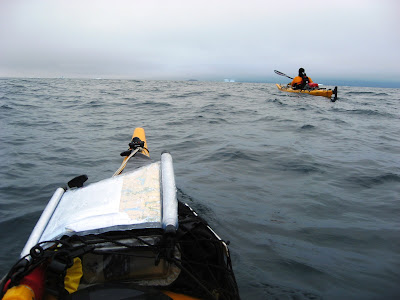This is a video clip which describes our journey
Turn your speakers on, pour a glass of whisky with lots of ice and enjoy yourself
This is a video clip which describes our journey
Turn your speakers on, pour a glass of whisky with lots of ice and enjoy yourself

Very strong winds
Wind calmed in the night
We left our camp at 2am and paddled till 9 am
we are now about 1-1.5 days paddle from Upernavik.
There are lots of harp seals in the area and birds colonies
Updates are Received By Satellite Phone and are updated by tal shani
Weather Support is Provided By Karel Vissel
We got some supply, the village people were very freindly and helpfull
We are most of the time in open sea, there are strong winds up to force 6 We had to land early due to strong head winds We are heading north to upernavik



In 1963, scientists described a phobic like syndrome, "Kayak-angst", as it appeared in West Greenland.
The study was published in the: "Int J Soc Psychiatry" According to the study, it is an irrational sudden anxiety, dizziness and fear of dying -- while paddeling in placid sea.
It occurs mainly in foggy conditions, with calm seas, on open water. The kayaker can't distinguish the horizon and loses the ability to determine up from down.


Now about 10km NW of Tasiusaq

strong head winds but dry and sunny.
heading to a Kuk setlement, we dont know if it is habitant
we are going to cross a very icy fjord now
Updates are Received By Satellite Phone and are updated by tal shani

HI ALL
Position 74 28N 57 16W
Thunder of breaking ice bergs every few minutes
We are sout of Nuussuaq vilage
We were invited there for coffee and whale meat
Great view and great people (Thanks Peter!)
Updates are Received By Satellite Phone and are updated by tal shani
Peter Reimer Kristensen and Alam Brook in Nuussuaq

After packing all the gear went up north .
The weather is goot the landscape is fantastic
Navigation and Safety gear :
PFDs: Extrasport (c) Pro creeker (Extrasport)
Paddle float
Towing system
Satellite Phone (Iridum)
PLB
VHF
Rifle
Various Cord / Rope
Multi Tool and repair kit
GPS x 2
Deck compass x2
hand held compass x2
barometer
Maps with water proof cases
Survival Kit and First aid
Photographic equipment:
D-SLR camera: Cannon EOS 400D with 18-200mm OS lenses
Digital Water proof small camera (Pentax optio 6)
Video Camera (Panasonic)
Spares batteries
Extra memory card, Back up Memory stick and Data copier
Solar Panels
Clothing and Camping gear
Tent: K2 eureka 4 season, geodesic dome tent (Eureka!)
sleeping bags
sleeping mats (thermarest)
Gore-Tex Dry suit (Kokatat)
Fleece and Thermal Underwear and tops
Gloves and poggies
Shoes and water proof socks
Warm hats
Sunglasses
Personal stuff
Dry bags
Cooking equipment
Fuel (95% Alcohol)
Fishing Gear
This an fantastic scene from the classic film "Nanook of the North" by Robert Flaherty. The film was shot in 1922 and documents the life of Nanook, an Inuit hunter and his family as they struggle to survive in the harsh conditions of the arctic region. "Nanook of the North" is considered to be the first documentary ever made and is a truly joyous film experience
In June 2008, two team members of Terra-Santa Seakayaks Club: Alan Brook and Kobi Sade will begin an unsupported sea kayaking expedition from Kullorsuaq in north-west Greenland.
Kullorsuaq, which is located almost 1000km north of the arctic circle, will be reached by helicopter flying out of Upernavik. After paddling northwards for a few days to a location where the Greenlandic icecap approaches the ocean, the two kayakers will turn south exploring a region of remote wilderness and sparse Inuit villages for a period of about 4 weeks. The paddling distance is expected be about 600 km depending on the state of the sea ice and the weather conditions.
 Photo: Søren Nikolaj Sørensen
Photo: Søren Nikolaj Sørensen